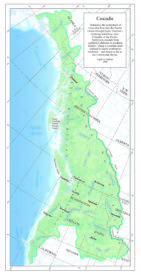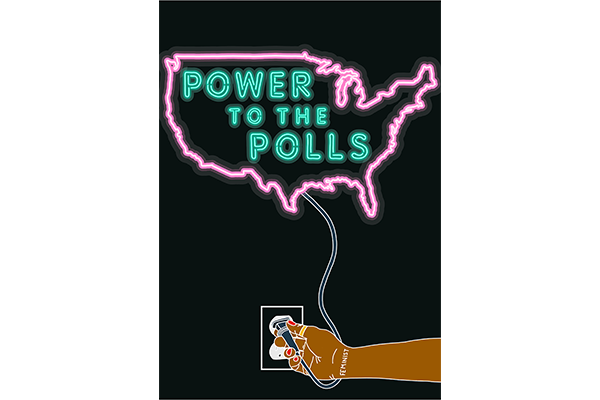Last update: noon, Thursday, Nov. 8.
In another epochal election night for the United States, Cascadia’s midterm election results were consistent with the nationwide US storyline. Republican gained in rural areas and, consequently, the Senate; and Democrats gained in suburban areas and, consequently, the House. A much-anticipated blue wave of Democratic victories won them control of the US House but left the national political map even more starkly divided between metropolitan and nonmetropolitan areas. In the Northwest, these trends showed up in the transfer of exactly one seat in Congress: a suburban and exurban district east of Seattle flipped from red to blue. Otherwise, the Northwest was already almost thoroughly split along the new political geography. A similar trend emerged in state legislatures: a wave turned a smattering of districts blue, almost all of them in metropolitan areas. The biggest shifts were in the blue states, Oregon and Washington, but even the reddest, Idaho, had a measurable leftward turn. The only exception was Alaska, which edged slightly rightward in its legislative makeup. It was also the only state where the party of its governor switched, and the party control of a legislative chamber will likely do the same — Republicans are on track to gain both. At the local level, concerns about housing, not the national contest between parties, held sway.
MORE RESULTS: How did Cascadia’s ballot measures do?
US Senate
Overall, Republicans appear on track to increase their edge in the US Senate from 51-49 to perhaps 54-46. In part, that outcome is simply a reflection of the vagaries of the calendar: this cycle put hardly any vulnerable Rs before voters for reelection, but it put up a lot of Ds in red and purple states, such as Heidi Heitkamp in North Dakota, a state now overrun with conservative oil workers laboring in the fracking fields of the Bakken Shale. (She lost.) For Democrats, not losing too many seats was a reasonable accomplishment; for Republicans, not to have won some would have been embarrassing.
But beyond the calendar, the US Senate is insulated from progressive voting waves by its very design: the Constitution gives absurdly exaggerated power in the Senate to low-population states such as Alaska and Wyoming. (The winner of the Senate race in Wyoming, incumbent Republican John Barrasso, racked up a total of 136,000 votes. That’s fewer than most winning candidates for the US House got elsewhere in Cascadia.) The Constitutional structure of the Senate is a form of pervasive and permanent gerrymandering. In this century, low-population states are overwhelmingly older, whiter, less prosperous, and more conservative than the diversely peopled big states that dominate the national economy and generate most of its innovation and technological progress. Progressive upwellings are most evident in the big states, already mostly represented by Democratic Senators. Many of the red states, in other words, have breakwaters that protect them from blue waves.
The partisan balance—indeed, the identities—of Cascadia’s Senators will remain unchanged by the election: seven Democrats and five Republicans. (For the purposes of this discussion, we’re adding all of Alaska, California, and Montana to Cascadia’s core jurisdictions of Idaho, Oregon, and Washington [plus British Columbia], though by Sightline’s map, only parts of these first three states are in Cascadia.)
Just three of the region’s dozen Senate seats were up for election this cycle, and only one—Montana Senator Jon Tester’s reelection campaign—was a competitive race. Because it was competitive, and because the US Senate hung in the balance, it was astronomically, gobsmackingly, unimaginably expensive, with super PACs and others pouring more than $60 million into the state to try to sway the decisions of fewer than half a million voters—more than $120 per voter!
Senator Tester clinched reelection, defeating Republican challenger Matt Rosendale. Tester won election in 2006 and reelection in 2012 partly thanks to Libertarian candidates who probably took more votes from his Republican challengers than from him. This time, the Libertarian candidate endorsed the GOP candidate just days before the election, though his party disavowed the endorsement and his name remained on the ballot. (If Montana used ranked-choice voting, such shenanigans wouldn’t matter.)
In the region’s only other US Senate races, incumbents Maria Cantwell (D-Wash.) and Diane Feinstein (D-Cali.) have always been expected to win reelection handily, and they have done so. Feinstein, now 85, defeated another Democrat, because California, like Washington, uses top-two rather than party primaries.
A few words more about the absurdly exaggerated influence of small-population states in the US Senate: Cascadia’s most populous states (Oregon and Washington, plus California, where the Redwood Coast is part of Cascadia) all have Democratic Senators. Its least populous states (Idaho and Alaska, of which the rainforest zone in the southeast and south are Cascadian) have Republican Senators. Montana’s 1 million people have one Senator from each party. Adding populations together, Cascadia’s Democratic Senators represent nine times more people each, on average, than its Republican Senators. Overall in these midterms, Republicans’ pick up of two seats in the chamber (as of Thursday) has come with losing the combined popular tally in those elections by more than 13 million votes. The US Senate is an anachronism; it is perhaps the least democratic national legislative body in the industrial world. Too bad it’s so hard to reform.
US House of Representatives

Map was drawn by Cynthia Thomas on the basis of forest data in Conservation International, Ecotrust, and Pacific GIS, “Coastal Temperate Rain Forests of North America,” Portland, 1995. See also, David D. McCloskey “Cascadia,” Cascadia Institute, Seattle, 1988.
We define Cascadia’s House delegation as including all representatives from Idaho, Oregon, and Washington, plus the at-large members from Alaska and Montana, and California’s 2nd district, which is on the Redwood Coast. Unlike the region’s Senate delegation, its House delegation does appear to be changing, mirroring the modest blue wave that shifted the US House to Democratic control.
Before the election, the region’s House delegation consisted of 11 Democrats and 9 Republicans—the Ds mostly from the coast and the Rs mostly from the interior. After the election, the delegation will have, if election night returns prove consistent with later returns, 12 Democrats and 8 Republicans, though many votes remain to count.
Only one of the 20 US House seats in Cascadia was an open race, in the suburbs east of Seattle, where Republican Dave Reichert declined to seek another term. There, pediatrician Kim Schrier, a Democrat, defeated former Republican State Senator Dino Rossi. Their contest was the most expensive US House race in state history.
State Legislatures
Cascadia’s urban-rural divide only seems to have widened this midterm election, as the national blue wave swept through metropolitan areas flipping suburban districts blue and, in contrast, as rural areas tended to get redder than they already were. Suburban Republicans lost legislative seats not only in blue Oregon and Washington but also in red Idaho and Montana. Only in Alaska did the legislature stay the same.
The Last Frontier State has just 574,000 registered voters—not many more than Seattle’s 463,000 and less than half as many as King County, Washington’s 1.3 million. Yet the state legislature still has a full complement of representatives and senators: 40 of the former and 20 of the latter.
For the last two years, an unusual coalition of 17 Democrats, 2 independents, and 2 Republicans have ruled the state House as the Alaska Majority Caucus. (Here’s more about how this “purple” caucus won office and then power.) With this election, the party balance has shifted two seats toward Republicans, but attempts to form a governing coalition in the House continued through the end of 2018.
Meanwhile, Republicans retained the state Senate but lost one seat, ending up with a 13-to-7 margin.
The new tally: State House: 23 Republicans, 16 Dems and one independent; Senate: 13 Republicans, seven Dems.
Democrats’ grip on Sacramento went from strong to very strong. They had 65 and 69 percent of the Senate and state Assembly respectively before the election. Afterward, their totals were 73 percent of the Senate and 75 percent of the Assembly: the two-thirds supermajorities in both houses required to raise taxes, plus the governorship.
Even so, it wasn’t mostly incumbents who were ousted in this politically polarized state. Instead, changes came from a handful of open seats—for example, the 12th senate district, in the Salinas Valley, where retiring Republican Anthony Cannella had cast the lone GOP vote in favor of last year’s transportation bill. (Its gas tax hike was also a key issue in the razor-thin race for his senate seat. Democrat Anna Caballero, who had voted for the same transportation bill in the Assembly, won.)
The new tally: State Assembly: 60 Dems, 20 Republicans; Senate: 29 Dems, 11 Republicans.
Politically, Idaho is a miniature inversion of California, but it’s even more lopsided. The state, with just 1.7 million residents, is as red as the Golden State is blue. Before the midterms, the GOP held more than 80 percent of seats in each chamber of the legislature. The national blue wave did manifest itself in Idaho, flipping four legislative seats, on net.
The new tally: State House: 56 Republicans, 14 Dems; Senate: 28 Republicans, seven Dems.
In increasingly Democratic Oregon, the major state legislative question wasn’t whether Democrats would win, but by how much. As it turned out, they added to their majorities by culling more moderate Republicans from Portland’s suburbs.
Because a voter-approved clause in Oregon’s constitution requires 60 percent of both the state House and Senate to agree on any tax hike, Democrats would need at least 36 votes in the House and at least 18 in the Senate to raise taxes without a voter referendum; they started the night one vote short in each house and finished it with supermajorities in both.
The supermajorities probably don’t matter to one of the state’s biggest issues in the upcoming session, a possible price on carbon pollution, because the proposed cap-and-trade auction system is a regulation, not a tax. But they have a potentially large impact on how (and whether) Oregon deals with its big shortfall in public employee pension funding, its public school quality, and other big-dollar issues.
On issues of housing regulation, meanwhile, voting tends to cut across party lines; some Republicans are willing to support more housing whether it arrives as infill or as sprawl, and a few Democrats are willing to oppose both. So it’s hard to predict the impact of tonight’s elections.
The new tally: State House: 38 Dems, 22 Republicans; Senate: 18 Dems, 12 Republicans.
Montana’s legislature going into the midterms was heavily Republican: 64 percent in the state senate and 59 percent in the state house. In other words, it wasn’t as red as Idaho, but it was still quite red. After the midterms, the legislature was one notch less Republican. Democrats picked up one more seat in the state House and two seats in the state Senate, but Republicans still held a commanding lead of both chambers.
The new tally: State House: 57 Republicans, 43 Dems; Senate: 30 Republicans, 20 Dems.
Democrats have expanded their control in Olympia.
In Washington’s 40th legislative district (Skagit, Whatcom, Island counties)—a blue stronghold to be sure—progressive Democrat Debra Lekanoff won in a landslide, making her only the second Native American woman to be elected to the state’s House of Representatives. Lekanoff has a long record as a champion of the environment and serving as an advisor to the EPA in the previous three presidential administrations on Salish Sea water regulations and vessel traffic.
The state Senate shifted from a 26-to-23 Democratic majority to a 29-to-20 majority. The state house, meanwhile, went from 50-to-48 for the Democrats to 57-to-41 for them. Of particular note: Republican State Senator Doug Ericksen, a prominent opponent of climate action, survived by in rural Whatcom County by just 45 votes.
The new tally: State House: 57 Dems, 41 Republicans; Senate: 29 Dems, 20 Republicans.
Governors
Oregon
Oregon Governor Kate Brown, whose agenda for 2019 includes a price on carbon pollution, is headed toward a second term, extending 32 years of Democratic control of the governor’s mansion in Salem.

Kate Brown Oregon Governor by Josh.goldberg used under CC BY-SA 3.0 (Used with permission)
Her opponent Knute Buehler, a Bend Republican, gave the Democratic Party its closest scare in eight years after hammering Brown over visible homelessness in downtown Portland and policies like a new statewide payroll tax for better bus service. Brown, who became governor in 2015 after her predecessor John Kitzhaber’s resignation, has reportedly called this campaign her last; major accomplishments so far include the nation’s first automatic voter registration law and a gradual minimum wage hike that varies by county. Her reelection keeps Oregon’s “cap-and-invest” climate plan alive, as well as the possibilities of state-level zoning reform and rent regulation.
Idaho & Alaska
In Idaho, Paulette Jordan, a young legislator and Coeur d’Alene tribal leader, drew national attention for her attempt to make inroads for Democrats in Cascadia’s most-conservative state. But in the end, she lost to Lieutenant Governor Brad Little, and Idaho’s string of Republican governors since 1995 will continue unbroken.
In Alaska, incumbent independent governor Bill Walker withdrew late in the race, after his name was already on the ballot, and endorsed his competitor on the left, former US Senator Mark Begich, a Democrat. Election observers projected Begich and Walker would likely split votes on the left and center, guaranteeing victory for tea party Republican Mike Dunleavy. Walker’s withdrawal simplified the three-way race, but it seems to have pushed voters in the center toward the right, not the left. Begich has lost to Dunleavy by 7.5 points, with Walker in single digits. Ranked-choice voting would have prevented this “spoiler” problem in the first place; it also would have given a fair shake to the 16 percent of voters who cast their ballot for Libertarian Bill Toien.
LOCAL RACES
In northern Cascadia, British Columbia, local election season wrapped up last month. You can read about some of those elections’ implications for housing policy, the marquee local issue, here.
South of the Canadian border, though, local results waited until tonight. The Portland area, in particular, saw some interesting races that will shape the politics and policy of urban sustainability for years to come.
Portland city council: Portland sent a political veteran to its open city council seat—but that was going to happen either way. Tuesday’s win went strongly to Joanne Hardesty, a former state legislator, county staffer and Navy veteran who has also led the local NAACP and helped lead the ultimately successful campaign to block the Columbia River Crossing freeway expansion through north Portland. Hardesty defeated Loretta Smith, a two-term county commissioner and longtime aide to US Sen. Ron Wyden. The two candidates, both progressive black women who came to Portland in young adulthood, agreed on much. But when they didn’t, Hardesty played outsider: she was willing to buck the five-member council’s existing consensus on policing (she’s for scaling back its scope), rent regulation (she’s tentatively for it), freeway expansion (she’s against it) and decongestion pricing (she’s against it, absent some better fix for involuntary displacement). Smith took the opposite side of all four issues. A reputation for cruelty to her staffers hurt Smith greatly; local newspapers unanimously endorsed Hardesty, all of them citing Smith’s allegedly poor professional conduct.
In Portland’s suburbs, where the clearest political divide is generally between “pro-freeway, pro-sprawl” and “pro-transit, pro-infill,” things look headed for a split decision.
In Portland’s largest suburban county, Clark County, Wash., anti-sprawl Democrat Eric Holt narrowly lost to anti-light-rail Republican Eileen Quiring in the race to lead the five-member council as its chair. And in the thriving technoburbs of Washington County, Ore., pro-transit Kathryn Harrington soundly defeated pro-highway Bob Terry for county chair—enough for her, Pam Treece and Dick Schouten to form a rough three-to-two urbanist majority on the powerful board. Harrington, a three-term councilor in the regional Metro government, promises a strong contrast with the last eight years under Andy Duyck, the board’s outgoing, pro-sprawl chair. At Metro, Harrington has been one of the most reliable votes for reducing auto-dependent development patterns and improving non-car transportation options.
Thanks to Sightline Research Associate Maithili Joshi for help with this article.










Dave H
Great article, lots of info! One item needs correction, however. Kate Brown became governor of Oregon in 2015, not 2012.
Anne Christnovich
Thanks, Dave! We’ve updated the article to correct that.